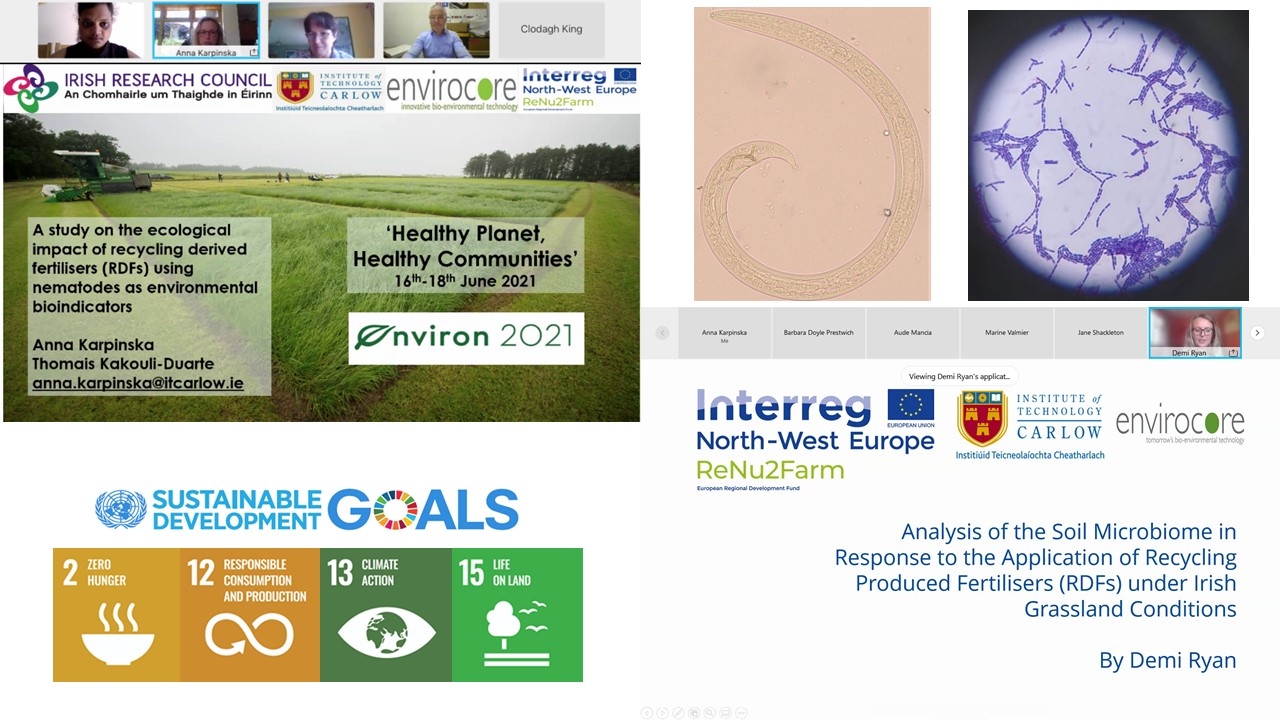The ReNu2Farm partners from the Institute of Technology Carlow (ITC) in Ireland participated again in this year’s Environ. Specifically, Ms Anna Karpinska offered an oral presentation entitled “A study on the ecological impact of recycling derived fertilisers (RDF) using nematodes as environmental bioindicators”, while Ms Demi Ryan offered an oral presentation entitled “Analysis of the soil microbiome in response to the application of recycling produced fertilisers under Irish grassland conditions”. The ReNu2Farm partners at enviroCORE in ITC have undertaken the task of completing the Deliverable 2.4 of our project, which focusses on reporting on the environmental impact of RDF on soil microbial and nematode diversity and abundance. The presentations highlighted results from field trials in Belgium and Ireland in 2019 and in Ireland in 2020. The soil biota chosen to do the environmental risk assessments on the RDF were selected due to their suitable characteristics for that purpose. Soil microbes provide key ecosystem services. Potential RDF induced variations in microbial community structure can influence and disrupt some of these important processes.
Nematodes are the most abundant and widespread animals in nature, involved in nutrient cycling and enabling these to be utilised by plants. Nematodes are sensitive to pollutants, respond quickly to environmental disturbance in the soil and therefore are ideal as biological indicators of environmental change, in this case potentially RDF induced. In particular, omnivore nematodes of the order Dorylaimida are sensitive to their environment and an overall decrease in their relative abundance would indicate pollution and environmental disturbance.
The findings of the ITC team revealed that RDF did not cause significant change in soil microbial diversity. Microbial communities were more responsive to addition of phosphorus than other nutrients. There was no evidence to suggest that RDF exhibit negative impacts on soil bacterial or fungal ecology. However, several bacterial and fungal taxa were enriched when cattle slurry was applied due to organic matter and carbon input. It was therefore evident that cattle slurry application altered the microbial community structure more than RDF.
Moreover, looking at the structures of the nematode communities, there were no differences among responses to potato waste struvite, municipal waste struvite and the controls. Struvites can be applied without posing a threat to terrestrial nematode communities.
Sewage sludge ash was recorded with the lowest number of observed nematode species and significantly decreased the number of pollution sensitive dorylaimids, when compared with the numbers in no fertiliser (NF) and SP 40 controls. Thus, sewage sludge ash may pose a risk to nematode communities in long-term use.
Poultry litter ash should only be applied in balancing nutrient conditions, as surplus negatively affected nematode communities in Irish 2019 trial. In the ammonium nitrate treated plots, a low number of nematode species was observed, and more so when results were compared to those in the untreated control and the CAN mineral control plots. Struvites and poultry litter ash were found most soil environment friendly regarding nematode responses, but the microbiome did not seem be affected by the RDF in general.
These results confirm that RDF do not have a negative impact in the soil ecosystem, providing thus viable alternatives against the unsustainable conventional mineral fertilisers.

